fuel pressure FIAT MULTIPLA 2006 1.G Owners Manual
[x] Cancel search | Manufacturer: FIAT, Model Year: 2006, Model line: MULTIPLA, Model: FIAT MULTIPLA 2006 1.GPages: 266, PDF Size: 4.61 MB
Page 109 of 266
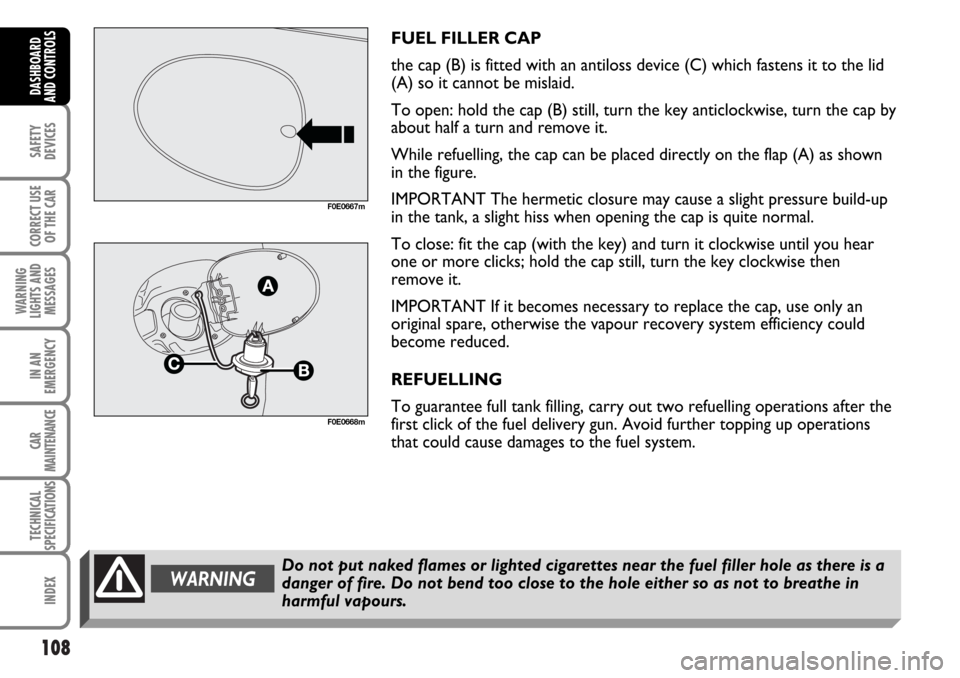
108
SAFETY
DEVICES
CORRECT USE
OF THE CAR
WARNING
LIGHTS AND
MESSAGES
IN AN
EMERGENCY
CAR
MAINTENANCE
TECHNICAL
SPECIFICATIONS
INDEX
DASHBOARD
AND CONTROLS
FUEL FILLER CAP
the cap (B) is fitted with an antiloss device (C) which fastens it to the lid
(A) so it cannot be mislaid.
To open: hold the cap (B) still, turn the key anticlockwise, turn the cap by
about half a turn and remove it.
While refuelling, the cap can be placed directly on the flap (A) as shown
in the figure.
IMPORTANT The hermetic closure may cause a slight pressure build-up
in the tank, a slight hiss when opening the cap is quite normal.
To close: fit the cap (with the key) and turn it clockwise until you hear
one or more clicks; hold the cap still, turn the key clockwise then
remove it.
IMPORTANT If it becomes necessary to replace the cap, use only an
original spare, otherwise the vapour recovery system efficiency could
become reduced.
REFUELLING
To guarantee full tank filling, carry out two refuelling operations after the
first click of the fuel delivery gun. Avoid further topping up operations
that could cause damages to the fuel system.
F0E0667m
Do not put naked flames or lighted cigarettes near the fuel filler hole as there is a
danger of fire. Do not bend too close to the hole either so as not to breathe in
harmful vapours.WARNING
F0E0668m
Page 144 of 266
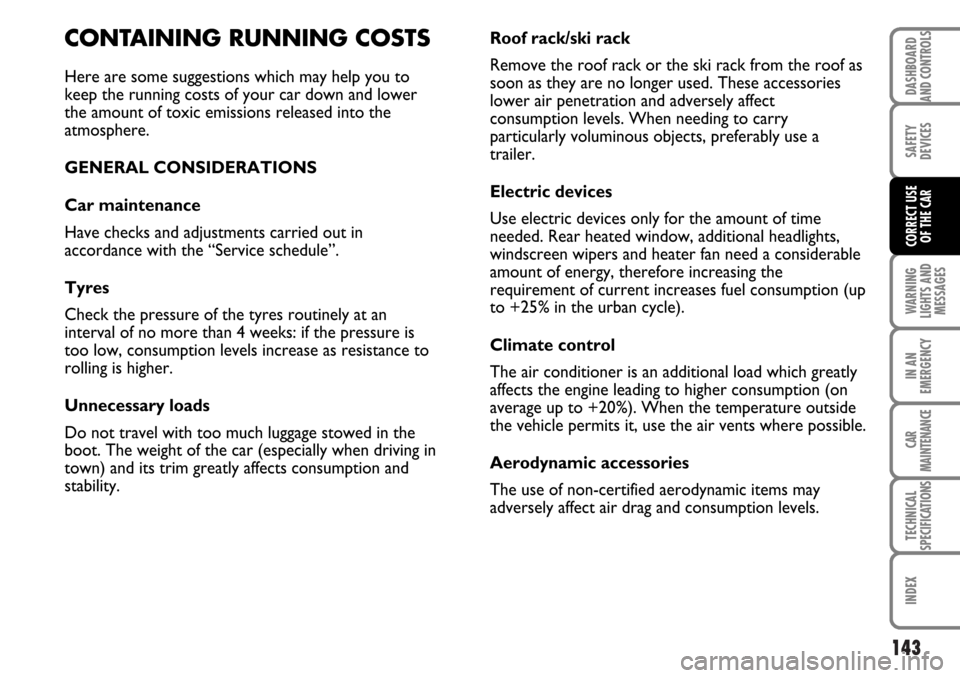
143
WARNING
LIGHTS AND
MESSAGES
IN AN
EMERGENCY
CAR
MAINTENANCE
TECHNICAL
SPECIFICATIONS
INDEX
DASHBOARD
AND CONTROLS
SAFETY
DEVICES
CORRECT USE
OF THE CAR
CONTAINING RUNNING COSTS
Here are some suggestions which may help you to
keep the running costs of your car down and lower
the amount of toxic emissions released into the
atmosphere.
GENERAL CONSIDERATIONS
Car maintenance
Have checks and adjustments carried out in
accordance with the “Service schedule”.
Tyres
Check the pressure of the tyres routinely at an
interval of no more than 4 weeks: if the pressure is
too low, consumption levels increase as resistance to
rolling is higher.
Unnecessary loads
Do not travel with too much luggage stowed in the
boot. The weight of the car (especially when driving in
town) and its trim greatly affects consumption and
stability.Roof rack/ski rack
Remove the roof rack or the ski rack from the roof as
soon as they are no longer used. These accessories
lower air penetration and adversely affect
consumption levels. When needing to carry
particularly voluminous objects, preferably use a
trailer.
Electric devices
Use electric devices only for the amount of time
needed. Rear heated window, additional headlights,
windscreen wipers and heater fan need a considerable
amount of energy, therefore increasing the
requirement of current increases fuel consumption (up
to +25% in the urban cycle).
Climate control
The air conditioner is an additional load which greatly
affects the engine leading to higher consumption (on
average up to +20%). When the temperature outside
the vehicle permits it, use the air vents where possible.
Aerodynamic accessories
The use of non-certified aerodynamic items may
adversely affect air drag and consumption levels.
Page 153 of 266
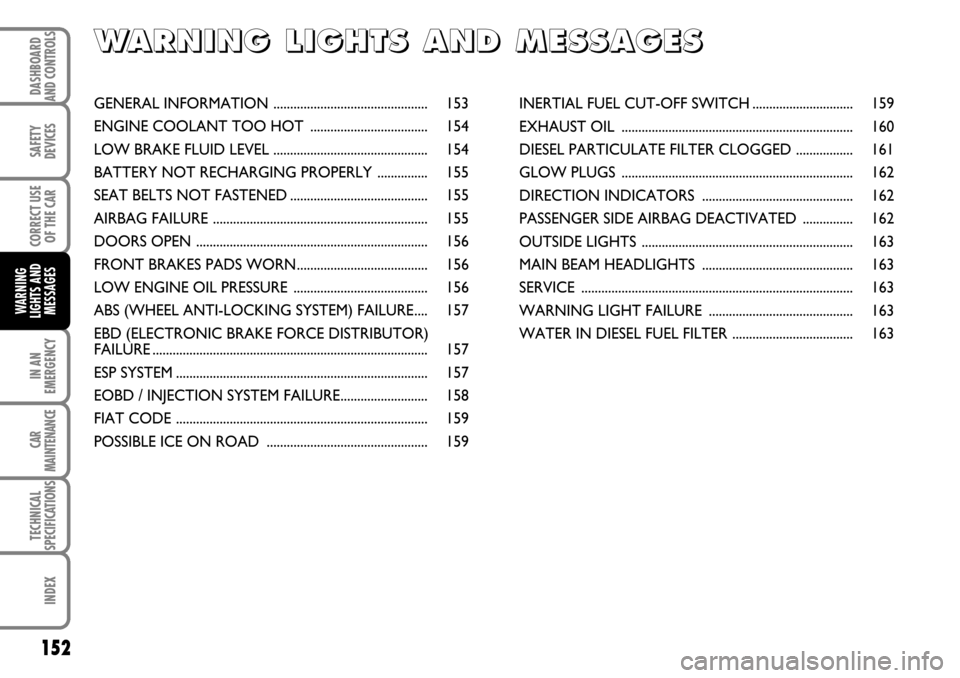
152
IN AN
EMERGENCY
CAR
MAINTENANCE
TECHNICAL
SPECIFICATIONS
INDEX
DASHBOARD
AND CONTROLS
SAFETY
DEVICES
CORRECT USE
OF THE CAR
WARNING
LIGHTS AND
MESSAGES
152
W W
A A
R R
N N
I I
N N
G G
L L
I I
G G
H H
T T
S S
A A
N N
D D
M M
E E
S S
S S
A A
G G
E E
S S
GENERAL INFORMATION .............................................. 153
ENGINE COOLANT TOO HOT ................................... 154
LOW BRAKE FLUID LEVEL .............................................. 154
BATTERY NOT RECHARGING PROPERLY ............... 155
SEAT BELTS NOT FASTENED ......................................... 155
AIRBAG FAILURE ................................................................ 155
DOORS OPEN ..................................................................... 156
FRONT BRAKES PADS WORN....................................... 156
LOW ENGINE OIL PRESSURE ........................................ 156
ABS (WHEEL ANTI-LOCKING SYSTEM) FAILURE.... 157
EBD (ELECTRONIC BRAKE FORCE DISTRIBUTOR)
FAILURE .................................................................................. 157
ESP SYSTEM ........................................................................... 157
EOBD / INJECTION SYSTEM FAILURE.......................... 158
FIAT CODE ........................................................................... 159
POSSIBLE ICE ON ROAD ................................................ 159INERTIAL FUEL CUT-OFF SWITCH .............................. 159
EXHAUST OIL ..................................................................... 160
DIESEL PARTICULATE FILTER CLOGGED ................. 161
GLOW PLUGS ..................................................................... 162
DIRECTION INDICATORS ............................................. 162
PASSENGER SIDE AIRBAG DEACTIVATED ............... 162
OUTSIDE LIGHTS ............................................................... 163
MAIN BEAM HEADLIGHTS ............................................. 163
SERVICE ................................................................................. 163
WARNING LIGHT FAILURE ........................................... 163
WATER IN DIESEL FUEL FILTER .................................... 163
Page 208 of 266
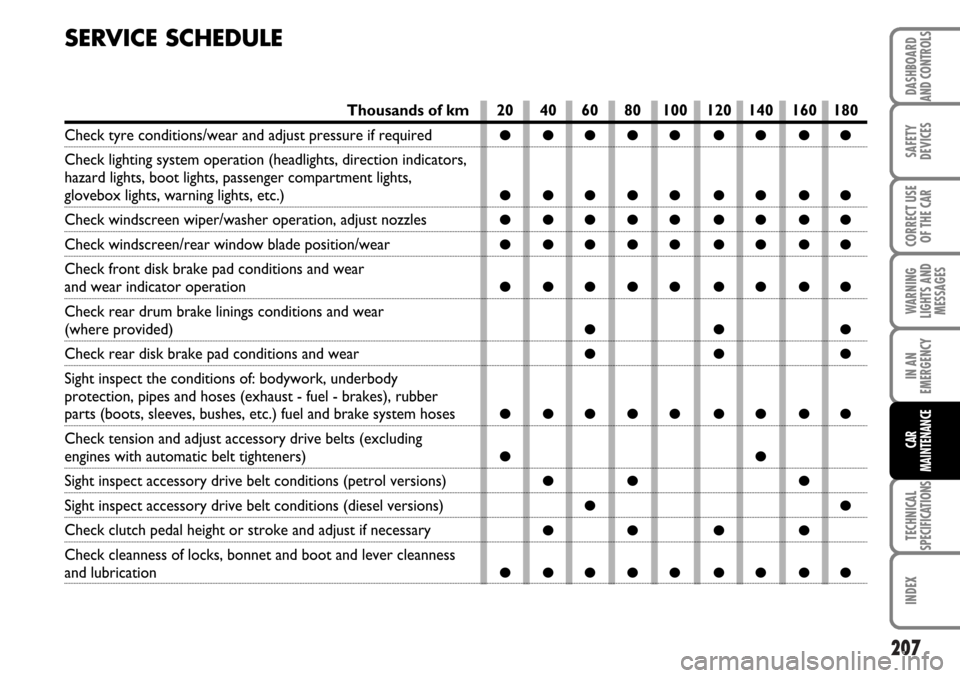
207
SAFETY
DEVICES
CORRECT USE
OF THE CAR
WARNING
LIGHTS AND
MESSAGES
TECHNICAL
SPECIFICATIONS
INDEX
DASHBOARD
AND CONTROLS
IN AN
EMERGENCY
CAR
MAINTENANCE
SERVICE SCHEDULE
20 40 60 80 100 120 140 160 180
●●●●● ●●●●
●●●●● ●●●●
●●●●● ●●●●
●●●●● ●●●●
●●●●● ●●●●
●●●
●●●
●●●●● ●●●●
●●
●● ●
●●
●● ● ●
●●●●● ●●●●
Thousands of km
Check tyre conditions/wear and adjust pressure if required
Check lighting system operation (headlights, direction indicators,
hazard lights, boot lights, passenger compartment lights,
glovebox lights, warning lights, etc.)
Check windscreen wiper/washer operation, adjust nozzles
Check windscreen/rear window blade position/wear
Check front disk brake pad conditions and wear
and wear indicator operation
Check rear drum brake linings conditions and wear
(where provided)
Check rear disk brake pad conditions and wear
Sight inspect the conditions of: bodywork, underbody
protection, pipes and hoses (exhaust - fuel - brakes), rubber
parts (boots, sleeves, bushes, etc.) fuel and brake system hoses
Check tension and adjust accessory drive belts (excluding
engines with automatic belt tighteners)
Sight inspect accessory drive belt conditions (petrol versions)
Sight inspect accessory drive belt conditions (diesel versions)
Check clutch pedal height or stroke and adjust if necessary
Check cleanness of locks, bonnet and boot and lever cleanness
and lubrication
Page 265 of 266
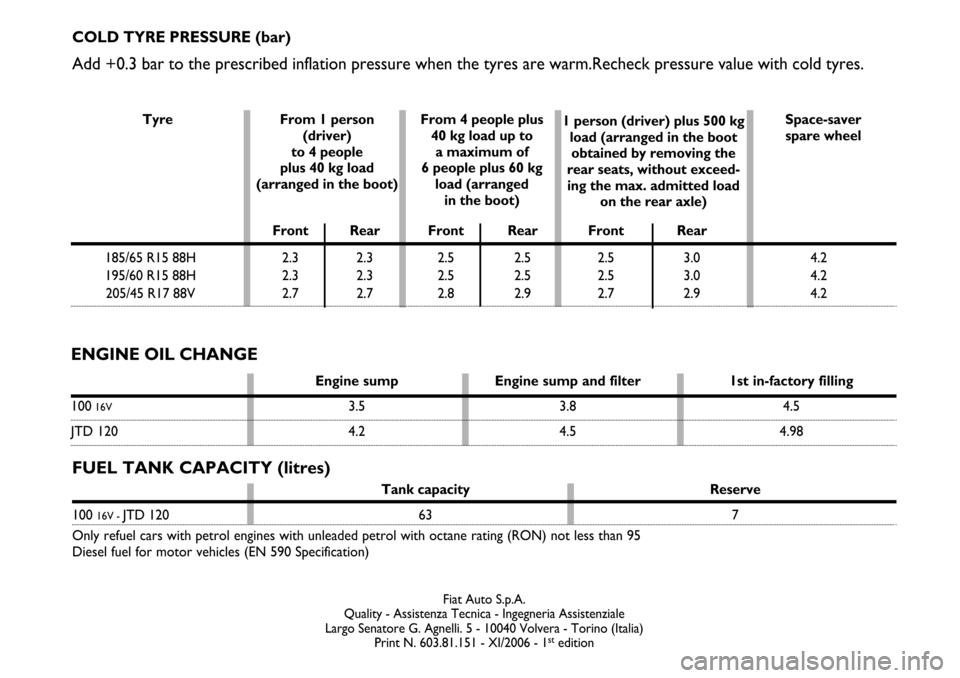
FUEL TANK CAPACITY (litres)
Tank capacity Reserve
100 16V - JTD 120 63 7
Only refuel cars with petrol engines with unleaded petrol with octane rating (RON) not less than 95
Diesel fuel for motor vehicles (EN 590 Specification)
Fiat Auto S.p.A.
Quality - Assistenza Tecnica - Ingegneria Assistenziale
Largo Senatore G. Agnelli. 5 - 10040 Volvera - Torino (Italia)
Print N. 603.81.151 - XI/2006 - 1
stedition
COLD TYRE PRESSURE (bar)
Add +0.3 bar to the prescribed inflation pressure when the tyres are warm.Recheck pressure value with cold tyres.
Space-saver
spare wheelTyre From 1 person
(driver)
to 4 people
plus 40 kg load
(arranged in the boot)From 4 people plus
40 kg load up to
a maximum of
6 people plus 60 kg
load (arranged
in the boot)1 person (driver) plus 500 kg
load (arranged in the boot
obtained by removing the
rear seats, without exceed-
ing the max. admitted load
on the rear axle)
ENGINE OIL CHANGE
Engine sump Engine sump and filter 1st in-factory filling
10016V3.5 3.8 4.5
JTD 120 4.2 4.5 4.98
Front Rear Front Rear Front Rear
185/65 R15 88H 2.3 2.3 2.5 2.5 2.5 3.0 4.2
195/60 R15 88H 2.3 2.3 2.5 2.5 2.5 3.0 4.2
205/45 R17 88V 2.7 2.7 2.8 2.9 2.7 2.9 4.2